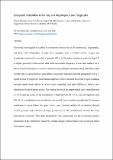| dc.contributor.author | Mziray, Prisca | |
| dc.contributor.author | Staehr, Peter | |
| dc.contributor.author | Christensen, Jesper | |
| dc.contributor.author | Kimirei, Ismael | |
| dc.contributor.author | Lugomela, Charles | |
| dc.contributor.author | Trolle, Dennis | |
| dc.contributor.author | O'Reilly, Catherine | |
| dc.date.accessioned | 2024-05-17T09:53:31Z | |
| dc.date.available | 2024-05-17T09:53:31Z | |
| dc.date.issued | 2024-06-24 | |
| dc.identifier.uri | https://doi.org/10.1016/j.jglr.2024.102337 | |
| dc.identifier.uri | https://dspace.nm-aist.ac.tz/handle/20.500.12479/2625 | |
| dc.description | This research article was published in the Journal of Great Lakes Research Volume 50, Issue 3, 2024 | en_US |
| dc.description.abstract | This study investigated variability in ecosystem metabolism in the meromictic, oligotrophic, and deep Lake Tanganyika. A large buoy equipped with a weather station, oxygen and temperature sensors for every 10 m down to 102 m depth and an irradiance sensor at 0 and 22 m depth, provided a three-month data with one-minute frequency. These data enabled us to derive detailed description of water column mixing and light conditions along with daily depth specific rates of gross primary production, ecosystem respiration and net production over a 3-month period. We applied a mass balance approach which included dissolved oxygen exchange between depth layers driven by mixed-layer deepening and eddy diffusivity from a one-dimensional hydrodynamic model. The vertical extent of the upper mixed layer varied between 21–40 m and the extent of the metalimnion varied between 48–75 m, with the euphotic zone (20–38 m) extending into the metalimnion on several days, providing enough light for primary production to occur below the upper mixed layer. Vertical profiles of metabolism showed several periods with elevated primary production in the metalimnion around the deep chlorophyll maximum. This deep productivity may compensate for the decreasing primary production in the epilimnion caused by climate change induced reductions in nutrient inputs from deeper waters. | en_US |
| dc.language.iso | en | en_US |
| dc.publisher | Elsevier | en_US |
| dc.subject | Research Subject Categories::FORESTRY, AGRICULTURAL SCIENCES and LANDSCAPE PLANNING | en_US |
| dc.title | Ecosystem metabolism in the deep and oligotrophic Lake Tanganyika | en_US |
| dc.type | Article | en_US |

